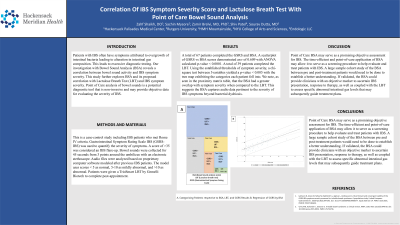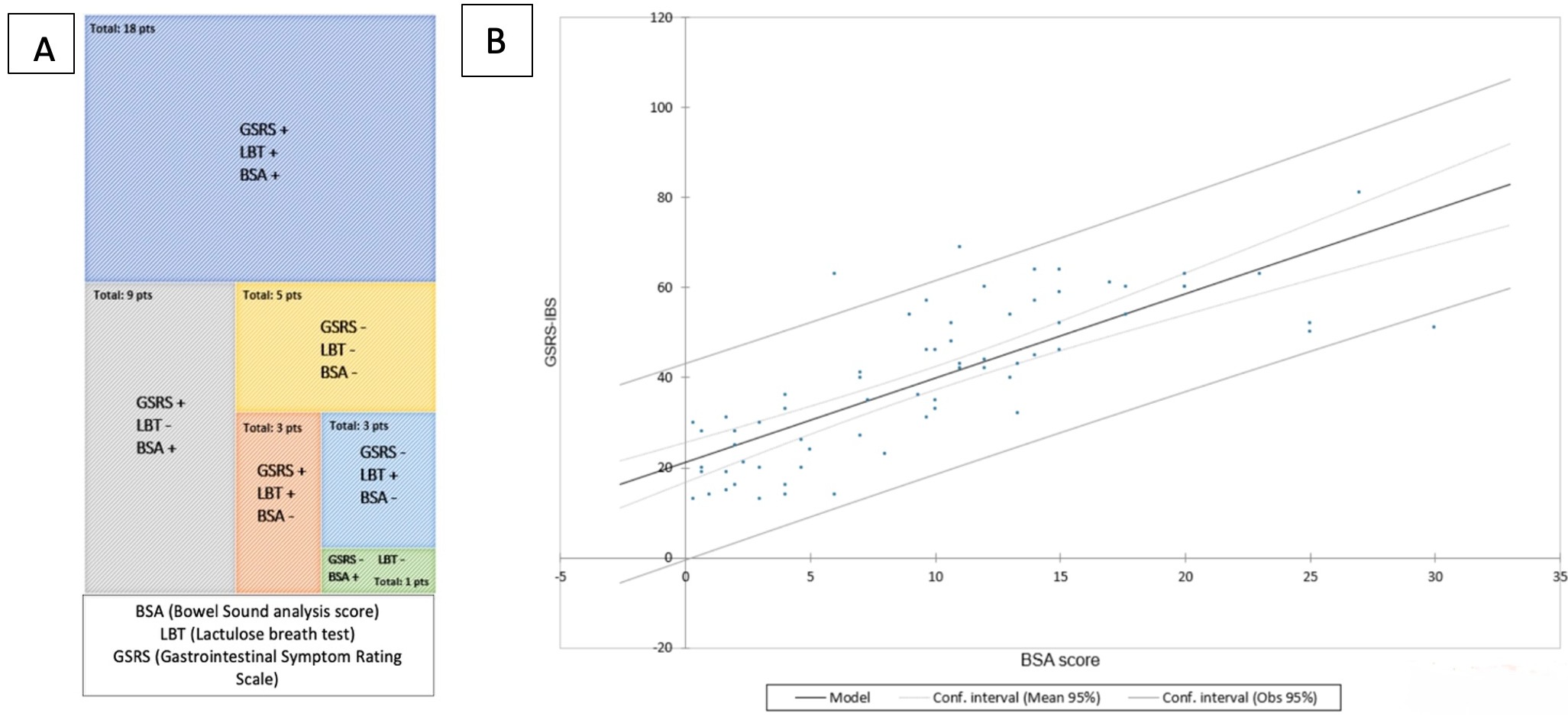Tuesday Poster Session
Category: Functional Bowel Disease
P3364 - Correlation of IBS Symptom Severity Score and Lactulose Breath Test With Point of Care Bowel Sound Analysis
Tuesday, October 24, 2023
10:30 AM - 4:00 PM PT
Location: Exhibit Hall

Has Audio
- ZS
Zahf Shaikh, DO
Hackensack Meridian Palisades Medical Center
North Bergen, NJ
Presenting Author(s)
Zahf Shaikh, DO1, Sachin Mysore, 2, Zamir Brelvi, MD, PhD3, Shiv Patel, 4, Sourav Dutta, MD3
1Hackensack Meridian Palisades Medical Center, North Bergen, NJ; 2Rutgers University, New Brunswick, NJ; 3Endologic LLC, Montville, NJ; 4NYU College of Arts and Sciences, New York, NY
Introduction: Patients with IBS often have symptoms attributed to overgrowth of intestinal bacteria leading to alteration in intestinal gas composition. This leads to excessive diagnostic testing. Our investigation with Bowel Sound Analysis (BSA) reveals a correlation between bowel sound activity and IBS symptom severity. This study further explores BSA and its proposed correlation with Lactulose BreathTest (LBT) and IBS symptom severity. Point of Care analysis of bowel sounds is a potential diagnostic tool that is non-invasive and may provide objective data for evaluating the severity of IBS.
Methods: This is a case-control study including IBS patients who met Rome IV criteria. GastrointestinalSymptom Rating Scale IBS (GSRS-IBS) was used to quantify the severity of symptoms. A score of >35 was considered an IBS flare-up. Bowel sounds were collected for 45 seconds from 3 points around the umbilicus with an electronic stethoscope. Audio files were analyzed based on proprietary computer software modeled after previous IBS patients. The model uses scores < 5 as normal, 5-10 as mildly abnormal, and >10 as abnormal. Patients were given a TrioSmart LBT by Gemelli Biotech to complete post-appointment.
Results: A total of 67 patients completed the GSRS and BSA. A scatterplot of GSRS vs BSA scores demonstrated an r of 0.609 with ANOVA calculated p-value < 0.0001. A total of 39 patients completed the LBT. Using the established thresholds of symptom severity, a chi-square test between 3 variables yielded a p-value < 0.005 with the tree map exhibiting the categories each patient fell into. We note, as seen in the proximity matrix table, that the BSA had a greater overlap with symptom severity when compared to the LBT. This suggests the BSA captures audio data pertinent to the severity of IBS symptoms beyond bacterial dysbiosis.
Discussion: Point of Care BSA may serve as a promising objective assessment for IBS. The time-efficient and point-of-care application of BSA may allow it to serve as a screening procedure to help evaluate and treat patients with IBS. A large sample cohort study of the BSA between pre and post-treatment patients would need to be done to establish a better understanding. If validated, the BSA could provide clinicians with an objective marker to ascertain IBS presentation, response to therapy, as well as coupled with the LBT to assess specific abnormal intestinal gas levels that may subsequently guide treatment plans.

Disclosures:
Zahf Shaikh, DO1, Sachin Mysore, 2, Zamir Brelvi, MD, PhD3, Shiv Patel, 4, Sourav Dutta, MD3. P3364 - Correlation of IBS Symptom Severity Score and Lactulose Breath Test With Point of Care Bowel Sound Analysis, ACG 2023 Annual Scientific Meeting Abstracts. Vancouver, BC, Canada: American College of Gastroenterology.
1Hackensack Meridian Palisades Medical Center, North Bergen, NJ; 2Rutgers University, New Brunswick, NJ; 3Endologic LLC, Montville, NJ; 4NYU College of Arts and Sciences, New York, NY
Introduction: Patients with IBS often have symptoms attributed to overgrowth of intestinal bacteria leading to alteration in intestinal gas composition. This leads to excessive diagnostic testing. Our investigation with Bowel Sound Analysis (BSA) reveals a correlation between bowel sound activity and IBS symptom severity. This study further explores BSA and its proposed correlation with Lactulose BreathTest (LBT) and IBS symptom severity. Point of Care analysis of bowel sounds is a potential diagnostic tool that is non-invasive and may provide objective data for evaluating the severity of IBS.
Methods: This is a case-control study including IBS patients who met Rome IV criteria. GastrointestinalSymptom Rating Scale IBS (GSRS-IBS) was used to quantify the severity of symptoms. A score of >35 was considered an IBS flare-up. Bowel sounds were collected for 45 seconds from 3 points around the umbilicus with an electronic stethoscope. Audio files were analyzed based on proprietary computer software modeled after previous IBS patients. The model uses scores < 5 as normal, 5-10 as mildly abnormal, and >10 as abnormal. Patients were given a TrioSmart LBT by Gemelli Biotech to complete post-appointment.
Results: A total of 67 patients completed the GSRS and BSA. A scatterplot of GSRS vs BSA scores demonstrated an r of 0.609 with ANOVA calculated p-value < 0.0001. A total of 39 patients completed the LBT. Using the established thresholds of symptom severity, a chi-square test between 3 variables yielded a p-value < 0.005 with the tree map exhibiting the categories each patient fell into. We note, as seen in the proximity matrix table, that the BSA had a greater overlap with symptom severity when compared to the LBT. This suggests the BSA captures audio data pertinent to the severity of IBS symptoms beyond bacterial dysbiosis.
Discussion: Point of Care BSA may serve as a promising objective assessment for IBS. The time-efficient and point-of-care application of BSA may allow it to serve as a screening procedure to help evaluate and treat patients with IBS. A large sample cohort study of the BSA between pre and post-treatment patients would need to be done to establish a better understanding. If validated, the BSA could provide clinicians with an objective marker to ascertain IBS presentation, response to therapy, as well as coupled with the LBT to assess specific abnormal intestinal gas levels that may subsequently guide treatment plans.

Figure: A. Categorizing Patients respective to BSA, LBT, and GSRS Results
B. Regression of GSRS by BSA
B. Regression of GSRS by BSA
Disclosures:
Zahf Shaikh indicated no relevant financial relationships.
Sachin Mysore indicated no relevant financial relationships.
Zamir Brelvi indicated no relevant financial relationships.
Shiv Patel indicated no relevant financial relationships.
Sourav Dutta indicated no relevant financial relationships.
Zahf Shaikh, DO1, Sachin Mysore, 2, Zamir Brelvi, MD, PhD3, Shiv Patel, 4, Sourav Dutta, MD3. P3364 - Correlation of IBS Symptom Severity Score and Lactulose Breath Test With Point of Care Bowel Sound Analysis, ACG 2023 Annual Scientific Meeting Abstracts. Vancouver, BC, Canada: American College of Gastroenterology.
